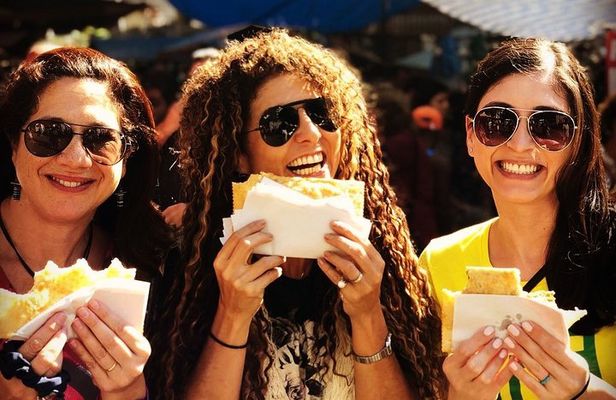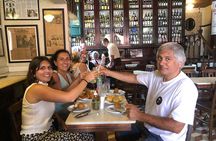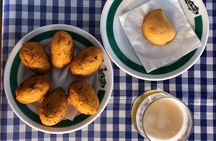
No expiration date
Easy refund
Free exchange
Easy booking
Food Tour Experience in Rio de Janeiro - Private Tour
$300
This is an experience gift voucher. The recipient will book the experience after
they redeem the gift voucher.
Overview
If you love travelling and you love food, you will love this tour. Brazil is an enormous tropical country and its gastronomy is an explosion of flavors. This tour is a depth immersion in Brazilian culinary and it is also a lovely way of exploring the city of Rio de Janeiro. In the company of a licensed guide, you will visit farmers markets, traditional restaurants and bars only known by the locals. The tour guide will be very informative about art, history, culture and the architecture of the neighbourhoods. The menu includes traditional food such as: Tapioca crepes and cheese bread ( both gluten-free ), açai, café, cachaça, caipirinha, pastel, coxinha, brigadeiro, sweets and cakes, sugarcane juice, Brazilian nuts, fruits, juices and craft beer. You can also choose one typical meal. This menu varies a little depending on the places visited .
We also have options for vegetarians.
This tour is in small groups, (no more than 10 people).
We will walk and use our own transportation
We also have options for vegetarians.
This tour is in small groups, (no more than 10 people).
We will walk and use our own transportation
—
Private Food Tour
Duration: 5 hours
Pickup included
Duration: 5 hours
Pickup included
Tour guide
Language: English
Human tour guide
- Licensed Tour Guide
- Coffee and/or Tea
- Food and Drinks were carefully selected to make this experience unique. The menu includes (Fruits, Juices, drinks, snacks and traditional meals) with options for vegetarians.
- Snacks
- Private Transportation A/C
- 2 Alcoholic beverages are included
- Soda/Pop
- Every day the farmers market takes place in a different neighbourhood, for this reason, the itinerary change a little (pass by)
- Santa Teresa is also a vibrant gastronomic center, as well as an artistic center. Due to a large number of artists and art studios, the neighborhood has come to be called Rio's Montmartre. (pass by)
- It is the popular name of a major public square in the center of Rio de Janeiro, Brazil. Its official name is Praça Floriano Peixoto, in honor of the second president of Brazil, Floriano Peixoto. The square concentrated a great part of the political and cultural life of Brazil. (pass by)
- The Carioca Aqueduct is located in the center of the city, in the Lapa neighborhood, and is frequently called Arcos da Lapa (Lapa Arches) by Brazilian people. The aqueduct was built in the middle of the 18th century to bring fresh water from the Carioca River to the population of the city. It is a typical example of colonial architecture and engineering. (pass by)
-
Escadaria SelaronThis tour is a deep immersion in Brazilian culinary and is also a lovely way of exploring the city of Rio de Janeiro. In the company of a licensed guide, you will visit markets, restaurants, bars and you will learn about art, history, culture and architecture of the area visited.
- It is the historic downtown, the building of neoclassical characteristics and in the past was launched in 1880, making the Francisco Joaquim Bethencourt da Silva (1831-1912) project, an architect from the Imperial house, founder of the Propagadora Society of Fine Arts and the Arts and Crafts Lyceum. (pass by)
- In a neoclassical building dating from 1820, the Casa França-Brasil sponsors small-scale exhibitions that often deal with political and cultural facets of carioca society. There are occasional concerts held on the veranda. The classical revival building once served as a customs house. (pass by)
- The heart of the Port Area. From 1910 on, with the inauguration of Porto do Rio (“Rio’s Port”), began an important place to welcome ships that brought products and tourists to the city. Around the square, there are important buildings, such as the Rio Art Museum (MAR) and the Museum of Tomorrow, as well as the A Noite building, the first skyscraper of the city, built in 1930. In the middle of the square, there’s the statue of Barão de Mauá, Irineu Evangelista de Souza, a great businessman from the time of the Empire. (pass by)
- Museum of Tomorrow is an Applied Sciences museum that explores the opportunities and challenges which humanity will be forced to tackle in the coming decades from the perspective of sustainability and conviviality. (pass by)
- The Museum of Art promotes a transversal reading of the city’s history, its social fabric, its symbolic life, conflicts, contradictions, challenges, and social expectations. Its exhibitions unite historical and contemporary dimensions of art through national and international exhibitions of long and short duration. The museum also rises with a mission to insert art in public education, through its Escola do Olhar. (pass by)
- Located in Gamboa, the 2500 m² mural is signed by muralist Eduardo Kobra. One of the largest graphite panels stared the world, according to the Guinness World Record, is the newest tourist attraction in Rio de Janeiro was inspired by the Olympic rings representing the five continents and received the name of “ethnic groups”. The art is signed by Eduardo Kobra, which has works spread over 20 countries, such as England, France, the USA, Russia, Greece, Italy, Sweden, and Poland. (pass by)
- The Candelária Church is an important historical Roman Catholic church in the city of Rio de Janeiro. It was built and decorated during a long period, from 1775 to the late 19th century. The church combines a Portuguese colonial Baroque with later Neoclassical and Neo-Renaissance interior elements. (pass by)
- The Royal Portuguese Reading Room has the largest and most valuable literary of Portuguese outside Portugal. Constructed between 1880 and 1887, it has more than 350,000 volumes in a library, fully computerized, which brings together rare books from the XVI, XVII, and XVIII. The library receives a copy of Portugal for each of the works published in the country according to its status of “legal deposit”. The current headquarters building has the neomanuelino style that evokes the exuberant Gothic-Renaissance at the time of the Portuguese Discoveries. The facade, inspired by the Jeronimos Monastery in Lisbon, was carved in limestone in Lisbon and brought by ship to Rio. (pass by)
- Located in the Historic Downtown, the Pólo Saara is considered to be the largest open air mall of the State of Rio de Janeiro. Composed of eleven streets on the surroundings of Alfândega St., it has over 88 stores, most of which cater to the popular market. At the end of the 19th century, the region was originally occupied by immigrants of different nationalities who opened up small family business. The buildings of Saara still preserve the original architecture of that time. (pass by)
- Stained-glass windows, brocaded mirrors and marble countertops create a lavish setting for coffee or a meal here. Dating from the late 19th century, the Confeitaria Colombo serves desserts – including a good pastel de nata (custard tart) – befitting its elegant decor. (pass by)
- The architectural lines are eclectic style, feature the beginning of the century, built to headquarter a Brazilian Lloyd school. But it didn’t happen and the building was used, for more than 50 years, to make the administrative and operational post areas could work. the Centro Cultural Correios is marking the presence of the Institute in the city promoting events in many areas on many vacancies, like theater, video, music, arts with promotions and events in many areas focusing on the integration of carioca’s people with varied ways of artistic expression. (pass by)
- XV Square or Fifteenth of November Square is one of the most famous squares in the city center and there are still some very important buildings in the History of Rio de Janeiro and Brazil, besides having been the stage of historical events. (pass by)
- This enormous concrete cone (1964-1976) by architect Edgar de Oliveira da Fonseca has had its fair share of controversy. The edifice stands at a height of 106m with a 96m internal diameter. The cathedral's main door (18m high), adorned with bronze bas-reliefs, leads into the immense interior space, entirely devoid of any structure, which can hold some 20 000 people. At each cardinal point is a huge stained-glass window sloping down from the summit to the base. In the basement is a museum devoted to sacred art and a columbarium. (pass by)
- The Valongo Wharf is an old dock located in the port area of Rio de Janeiro. In 2011, during the excavations carried out as part of the revitalization works in the Rio de Janeiro port area, the two wharves - Valongo and Imperatriz - were discovered, one on top of the other, and, along with them, a large number of amulets and worship objects from Congo, Angola, and Mozambique. IPHAN and the city of Rio de Janeiro inscribed the wharf's archaeological site to the Unesco World Heritage Site Tentative List. The wharf was then officially designated a World Heritage Site in 2017. (pass by)
- At the entrance to this church is a small museum housing the statues of saints that are borne through the streets in the Ash Wednesday procession, of which the most remarkable is a St Louis dressed up as Louis XIII! The church's exuberant gilded wood decor (1700-1737), the work of Manuel and Francisco Xavier de Brito, constitutes one of Brazil's most accomplished examples of Baroque art. The Apotheosis of St Francis, on the ceiling of the nave, is the work of Caetano da Costa Coelho and is Brazil's first example of perspective in art. (pass by)
- The Santo Antônio Monastery, located on an esplanade overlooking the Largo da Carioca, attracts admiring stares from all sides. But it is the inside of the complex that is really worth seeing. Have a look inside the church, which is one of the most remarkable in Rio, with its sculpted, gilded wood apse and its remarkable painted ceiling in the confessional. At the very beginning of the 18C, the monastery protected Cariocas from the French. These days you will discover a haven of peace and quiet within this wonder of religious architecture. (pass by)
- The National Museum of Fine Art boasts 18 000 exhibits, making it the largest museum in the country. Here, you can admire works by Brazilian masters from the 19C (Victor Mereilles, Pedro Américo etc) and 20C (Maria Leontina, Iberê Camargo etc), as well as a fine series of paintings by Eugène Boudin. Contemporary artists are also represented, most notably, engravings by Carlos Oswald. The collection of engravings on display is one of the largest in Brazil. (pass by)
- The Brazilian National Library (BN) is the responsible agency for the governmental politics execution of capture, storage, preservation and diffusion of the Country’s intellectual production. With more than 200 years of history, it is the oldest Brazilian cultural institution. It has a heritage of approximately 9 million items and, therefore, was considered by UNESCO (Organization of United Nations for the Education, Science and Culture) as one of the main national libraries in the world. To guarantee the maintenance of this immense set of works, BN has restoration and conservation of paper laboratories, binding workshop, centers of microfilming, photograph and digitation. (pass by)
- Farmers Market Copavabana (pass by)
- Farmers Market Ipanema (pass by)
- It is no coincidence if the Theatro Municipal reminds you of Paris' Opera Garnier. The architects took inspiration from the French Opera House and had all the materials needed for its construction imported from Europe in 1905. The opening was even held on Bastille Day! The guided tour will acquaint you with the remarkable decor of the auditorium, the staircase, the vestibule and even the basement. And why not enjoy a show in the company of over 2 000 spectators? (pass by)
How it works?
01
—
You choose from 10,000+ experience gifts
02
—
We deliver the eVoucher or the Physical box to the recipient
03
—
Recipient books the experience and creates unforgettable memories!
Food Tour Experience in Rio de Janeiro - Private Tour
$300
This is an experience gift voucher. The recipient will book the experience after
they redeem the gift voucher.
How it works?
01
—
You choose from 10,000+ experience gifts
02
—
We deliver the eVoucher or the Physical box to the recipient
03
—
Recipient books the experience and creates unforgettable memories!




